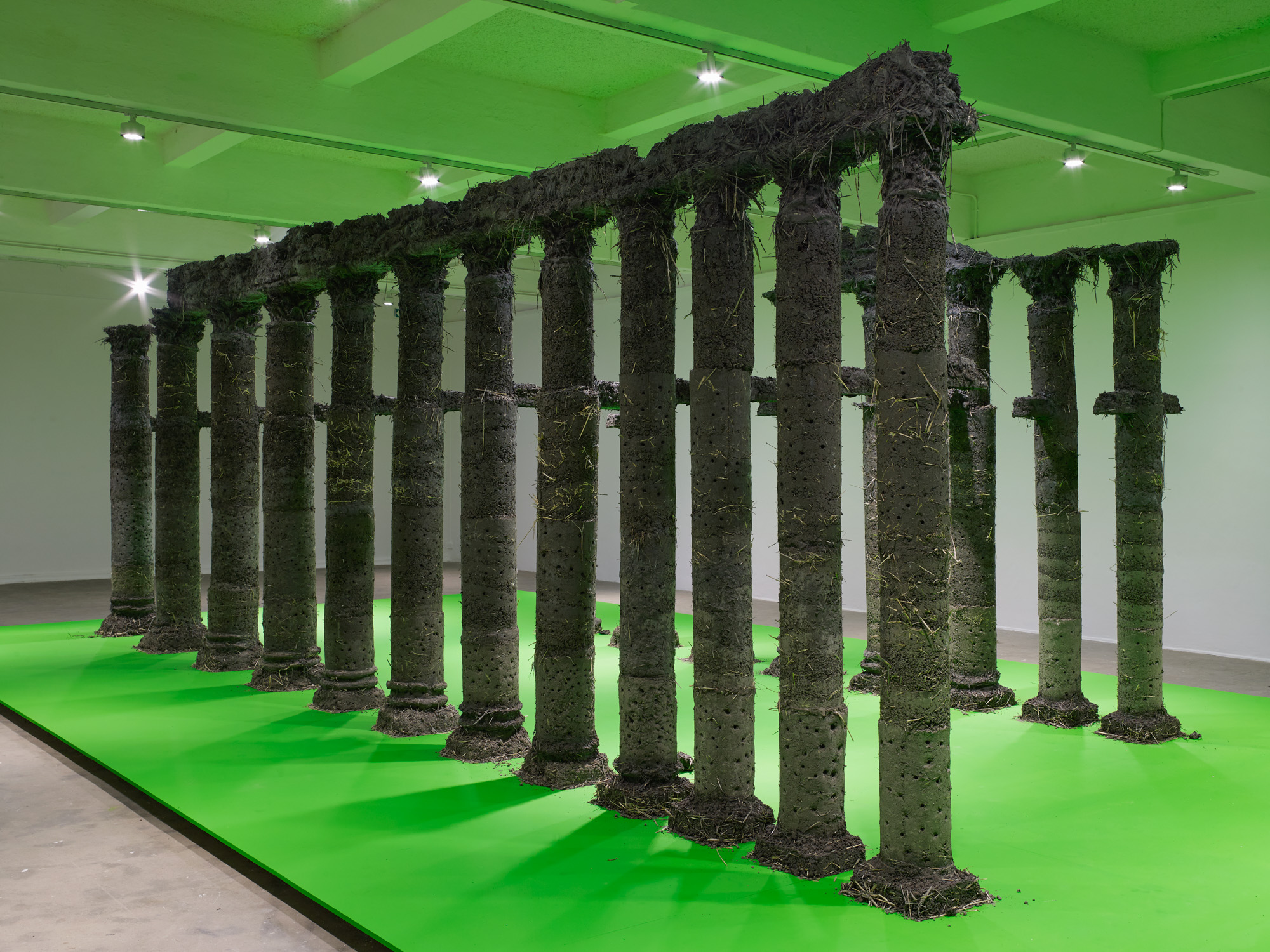Abbas Akhavan: “curtain call, variations on a folly”
By Christopher Whitfield

Installation view of ABBAS AKHAVAN
In August of 2015 the Islamic State published photos of their destruction of the Temple of Bel in the ancient city of Palmyra. Their propaganda boasted of the carnage as the militant group gained ground in their crusade through Iraq and Syria. The international community latched onto the images as it grieved for its loss in essays and editorials, monumentalizing the site as a testament to the worldly values of heritage and culture, stolen by the barbarism of sectarian violence. In the images, a towering plume of smoke stands in for the fallen temple. Only four spindly alabaster pillars remain upright in the foreground, survivors of the demolition that toppled their surroundings. Carved out against the roiling backdrop of murky gray, the meager remnants of Palmyra might as well have been anywhere. Likewise, Abbas Akhavan’s exhibition at London’s Chisenhale Gallery, “curtain call, variations on a folly,” teased an excavation of the ways such structures are constructed in the global imaginary, and transported beyond the contexts of their original settings.
The exhibition’s sole interior work referenced the colonnade that once led to the now-destroyed Arch of Palmyra. Built from cob—an archaic construction material of subsoil and dry grass—the muddy columns of curtain call, variations on a folly (2021) made a procession down the length of the space. The sculptures sat on a chroma-key green screen, which unfurled beneath the pillars like a carpet, before rising up into a vibrant backdrop that punctuated the far end of the gallery. It is not the first time that elements of the ruins of Palmyra have been the subject of sculpture. In 2016, a replica of the Arch was carved from Egyptian marble by the Oxford-based Institute of Digital Archaeology. The copy was installed in London’s Trafalgar Square, before touring to New York, Geneva, and Florence, among other cities, and subsequently re-gifted to the Syrian people. Benevolent as this gesture might seem, this cultural baton-passing around the West was also in service of the accumulation of sentimental ideology, the self-conscious appreciation of a seemingly dead thing, with no mention of complicity in the circumstance of its destruction. Meanwhile in Syria, reconstruction begins in November 2021. It is savvy, then, that Akhavan’s pillars are not a recreation, but a portrayal—as the title suggests, cob as an actor facing its audience and stepping into a role, more subject than object.
Monuments like the colonnade have long been typecast, called upon to perform the civilizing ideologies of heritage and culture, often in opposition to the various actors in the deeply complex plots of their region’s political theater. Akhavan’s green screen cleverly hints at the boundless possibilities of these roles, the fantastical worlds and alternative futures in which they could be staged. His chroma key screen challenges our cinematic imagination to transport the cob colonnade into any number of scenarios, but whether audiences at the Chisenhale’s white cube can rise to such a prompt may remain to be seen. After all, for many in the West it is scenes such as Palmyra’s plume of smoke, so readily shared in our media, that guide our ability to envision any context for these objects at all. Yet variations on a folly shrewdly holds its audience accountable to the ways in which they instrumentalize its subject, evoking histories of Western museological plunder that see artifacts spirited away from homes that have been destabilized by the very nations that purport to revere and protect their treasures.

Aerial view of ABBAS AKHAVAN
The hushed question that arises from Akhavan’s installation pertains to who is permitted the privilege of mobility. In a historical moment when those displaced by recent developments in decades-old conflicts are driven to seek asylum in droves—vetted by how well they meet certain personal and ideological criteria set by their host states—Akhavan’s monumental subjects permit us to query the perceived values that bestow the right to move. On the roof of the Chisenhale, the artist painted the words “CAT’S PAW.” The phrase, taken from Jean de La Fontaine’s fable “The Monkey and The Cat,” speaks to the experience of being used as a tool by another. The language canopies the work, enveloping the sculpture and its audience in a poetic shroud. Inaccessible to visitors, the quote, Akhavan claims, is only visible to birds and drones, a nod perhaps to the visual technologies of imperialism, the ways in which empire sees, knows, discerns the worth of things. From this vantage point the words are a label, naming the artifacts which circulate on global currents of culture as tools, whose usefulness buys their passage. Akhavan’s cob pillars, readied for take-off on his chroma key stage, hold us to the challenge of imagining those who are carried on global currents as multidimensional, and on their own terms.
Abbas Akhavan’s “curtain call, variations on a folly” is on view at Chisenhale Gallery, London, until October 17, 2021.
%20x%20135(H)%20px-03Rc-72dpi%20(2).jpg)






